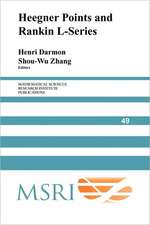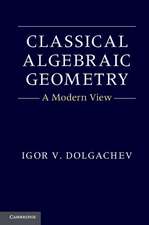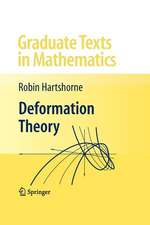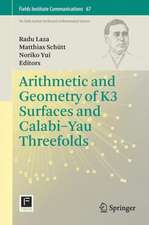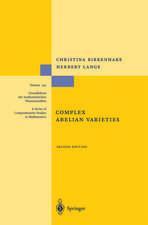An Invitation to Quantum Cohomology: Kontsevich's Formula for Rational Plane Curves: Progress in Mathematics, cartea 249
Autor Joachim Kock, Israel Vainsencheren Limba Engleză Hardback – 24 oct 2006
Din seria Progress in Mathematics
- 24%
 Preț: 691.37 lei
Preț: 691.37 lei - 24%
 Preț: 740.80 lei
Preț: 740.80 lei - 9%
 Preț: 763.33 lei
Preț: 763.33 lei -
 Preț: 308.20 lei
Preț: 308.20 lei - 20%
 Preț: 695.88 lei
Preț: 695.88 lei -
 Preț: 362.51 lei
Preț: 362.51 lei -
 Preț: 308.13 lei
Preț: 308.13 lei - 18%
 Preț: 749.27 lei
Preț: 749.27 lei - 9%
 Preț: 766.42 lei
Preț: 766.42 lei - 20%
 Preț: 631.09 lei
Preț: 631.09 lei - 24%
 Preț: 638.88 lei
Preț: 638.88 lei - 15%
 Preț: 580.82 lei
Preț: 580.82 lei -
 Preț: 392.37 lei
Preț: 392.37 lei -
 Preț: 395.09 lei
Preț: 395.09 lei -
 Preț: 390.25 lei
Preț: 390.25 lei -
 Preț: 376.80 lei
Preț: 376.80 lei - 18%
 Preț: 729.53 lei
Preț: 729.53 lei - 15%
 Preț: 652.49 lei
Preț: 652.49 lei - 15%
 Preț: 649.22 lei
Preț: 649.22 lei - 18%
 Preț: 897.95 lei
Preț: 897.95 lei -
 Preț: 385.08 lei
Preț: 385.08 lei -
 Preț: 391.02 lei
Preț: 391.02 lei -
 Preț: 378.54 lei
Preț: 378.54 lei - 15%
 Preț: 531.59 lei
Preț: 531.59 lei - 15%
 Preț: 642.83 lei
Preț: 642.83 lei - 15%
 Preț: 650.69 lei
Preț: 650.69 lei -
 Preț: 381.21 lei
Preț: 381.21 lei -
 Preț: 392.37 lei
Preț: 392.37 lei -
 Preț: 398.53 lei
Preț: 398.53 lei - 15%
 Preț: 699.28 lei
Preț: 699.28 lei -
 Preț: 416.92 lei
Preț: 416.92 lei -
 Preț: 385.84 lei
Preț: 385.84 lei - 18%
 Preț: 902.65 lei
Preț: 902.65 lei - 18%
 Preț: 802.28 lei
Preț: 802.28 lei - 15%
 Preț: 640.06 lei
Preț: 640.06 lei - 18%
 Preț: 1129.83 lei
Preț: 1129.83 lei
Preț: 525.66 lei
Preț vechi: 618.43 lei
-15% Nou
Puncte Express: 788
Preț estimativ în valută:
100.62€ • 109.33$ • 84.57£
100.62€ • 109.33$ • 84.57£
Carte tipărită la comandă
Livrare economică 21 aprilie-05 mai
Preluare comenzi: 021 569.72.76
Specificații
ISBN-13: 9780817644567
ISBN-10: 0817644563
Pagini: 159
Ilustrații: XIV, 162 p.
Dimensiuni: 155 x 235 x 13 mm
Greutate: 0.37 kg
Ediția:2007
Editura: Birkhäuser Boston
Colecția Birkhäuser
Seria Progress in Mathematics
Locul publicării:Boston, MA, United States
ISBN-10: 0817644563
Pagini: 159
Ilustrații: XIV, 162 p.
Dimensiuni: 155 x 235 x 13 mm
Greutate: 0.37 kg
Ediția:2007
Editura: Birkhäuser Boston
Colecția Birkhäuser
Seria Progress in Mathematics
Locul publicării:Boston, MA, United States
Public țintă
ResearchCuprins
Prologue: Warming Up with Cross Ratios, and the Definition of Moduli Space.- Stable n-pointed Curves.- Stable Maps.- Enumerative Geometry via Stable Maps.- Gromov—Witten Invariants.- Quantum Cohomology.
Recenzii
"The book seems to be ideally designed for a semester course or ambitious self-study." —Mathematical Reviews
"The book is intended to be a friendly introduction to quantum cohomology. It makes the reader acquainted with the notions of stable curves and stable maps, and their moduli spaces. These notions are central in the field. ... Each chapter ends with references for further readings, and also with a set of exercices which help fixing the ideas introduced in that chapter. This makes the book especially useful for graduate courses, and for graduate students who wish to learn about quantum cohomology." —Zentralblatt Math
"…The book is ideal for self-study, as a text for a mini-course in quantum cohomology, or a special topics text in a standard course in intersection theory. The book will prove equally useful to graduate students in the classroom setting as to researchers in geometry and physics who wish to learn about the subject" —Analele Stiintifice ale Universitatii “Al. I. Cuza” din Iasi
"The book is intended to be a friendly introduction to quantum cohomology. It makes the reader acquainted with the notions of stable curves and stable maps, and their moduli spaces. These notions are central in the field. ... Each chapter ends with references for further readings, and also with a set of exercices which help fixing the ideas introduced in that chapter. This makes the book especially useful for graduate courses, and for graduate students who wish to learn about quantum cohomology." —Zentralblatt Math
"…The book is ideal for self-study, as a text for a mini-course in quantum cohomology, or a special topics text in a standard course in intersection theory. The book will prove equally useful to graduate students in the classroom setting as to researchers in geometry and physics who wish to learn about the subject" —Analele Stiintifice ale Universitatii “Al. I. Cuza” din Iasi
Textul de pe ultima copertă
This book is an elementary introduction to stable maps and quantum cohomology, starting with an introduction to stable pointed curves, and culminating with a proof of the associativity of the quantum product. The viewpoint is mostly that of enumerative geometry, and the red thread of the exposition is the problem of counting rational plane curves. Kontsevich's formula is initially established in the framework of classical enumerative geometry, then as a statement about reconstruction for Gromov–Witten invariants, and finally, using generating functions, as a special case of the associativity of the quantum product.
Emphasis is given throughout the exposition to examples, heuristic discussions, and simple applications of the basic tools to best convey the intuition behind the subject. The book demystifies these new quantum techniques by showing how they fit into classical algebraic geometry.
Some familiarity with basic algebraic geometry and elementary intersection theory is assumed. Each chapter concludes with some historical comments and an outline of key topics and themes as a guide for further study, followed by a collection of exercises that complement the material covered and reinforce computational skills. As such, the book is ideal for self-study, as a text for a mini-course in quantum cohomology, or as a special topics text in a standard course in intersection theory. The book will prove equally useful to graduate students in the classroom setting as to researchers in geometry and physics who wish to learn about the subject.
Emphasis is given throughout the exposition to examples, heuristic discussions, and simple applications of the basic tools to best convey the intuition behind the subject. The book demystifies these new quantum techniques by showing how they fit into classical algebraic geometry.
Some familiarity with basic algebraic geometry and elementary intersection theory is assumed. Each chapter concludes with some historical comments and an outline of key topics and themes as a guide for further study, followed by a collection of exercises that complement the material covered and reinforce computational skills. As such, the book is ideal for self-study, as a text for a mini-course in quantum cohomology, or as a special topics text in a standard course in intersection theory. The book will prove equally useful to graduate students in the classroom setting as to researchers in geometry and physics who wish to learn about the subject.
Caracteristici
Elementary introduction to stable maps and quantum cohomology presents the problem of counting rational plane curves Viewpoint is mostly that of enumerative geometry Emphasis is on examples, heuristic discussions, and simple applications to best convey the intuition behind the subject Ideal for self-study, for a mini-course in quantum cohomology, or as a special topics text in a standard course in intersection theory


